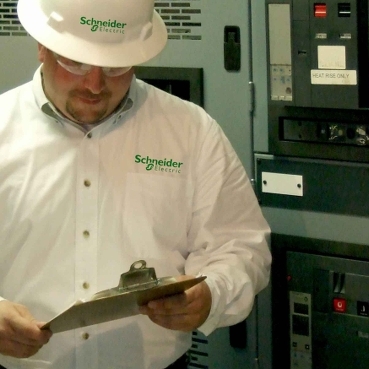Microgrids: What You Need to Know
Microgrids: What You Need to Know
We've built more microgrids in the U.S. than anyone else. And now, with energy-as-a-service financing, we can help you build a microgrid with zero upfront cost.
_BUILDER.IOHorizontal.webp)
What is a microgrid?
A microgrid is a self-contained electrical network that allows you to generate your own electricity on-site and use it when you need it most. A microgrid is thus a type of distributed energy resource. You can operate microgrids while connected to the utility grid or in disconnected “island” mode. When the grid goes down or electricity prices peak, microgrids respond.
How do microgrids work?

A microgrid co-locates electricity generation and consumption. Unlike the utility grid, which generates electricity in a centralized power plant and then distributes it along hundreds of miles of transmission lines, a microgrid generates electricity on-site.
For electricity generation, microgrids typically use some combination of back-up diesel generators and renewables such as solar panels. Microgrids can incorporate battery systems to store electricity and deploy it during outages or when grid demand spikes.
Intelligent software controls can automatically switch the facility between the utility grid and the microgrid based on factors such as power reliability and cost efficiency.

Explore our software, services, and products for Microgrids
Who can benefit from a microgrid?
Early adopters of microgrids included hospitals, data centers, and other facilities where reliability and resiliency are essential. Today, organizations of all kinds are turning to microgrids and distributed energy resources for financial and sustainability benefits.
We’ve worked with a diverse set of customers: from municipal governments and military bases to nature preserves and vertical farms. Any organization seeking to gain control over energy costs, advance sustainability, and increase resiliency can benefit from a microgrid.
Additionally, as infrastructure, industry, and buildings continue to become more electrified, microgrids can help generate power for additional loads. For example, increased power needs for EV chargers or electrification of heating.
What microgrid services are available?
No matter where you're at in your microgrid journey, Schneider Electric can help. Our microgrid services span all stages, including:
- Consulting to design your system and offer insight throughout the project lifecycle
- Modernization to upgrade existing equipment.
- Startup and commissioning to inspect and test equipment, ensuring proper setup and functionality
- Maintenance to keep systems running and ensure successful outcomes.
How much does a microgrid cost to build?
The honest answer is, “It depends.” Microgrids range dramatically in complexity and size.
The exciting answer for organizations is that it can be done with low financial risk. Our energy-as-a-service model allows you to upgrade your energy infrastructure with a customized solution — including a microgrid — and plan ahead with predictable long-term pricing.
If you prefer to build your own microgrid, the costs will vary depending on system size and capabilities. Reach out to us here and we’ll talk through your project.
What is energy-as-a-service?

Energy-as-a-service (EaaS) is a financing model for microgrids that allows you to avoid upfront costs. Similar to a software-as-a-service model, with EaaS you avoid capital expenditures and instead pay only for ongoing service.
Schneider Electric and our strategic partner, the Carlyle Group, have joined forces to create AlphaStruxure, a venture that is solving the world’s most complex energy challenges. AlphaStruxure will finance, build, and maintain your microgrid.
See how our customers benefit from Microgrids
Explore our latest insights on Microgrids
You might also be interested in:
1. Microgrid solutions from Schneider Electric
Schneider Electric offers efficient microgrid solutions based on a combination of Edge Control Systems, Connected Products, Applications, Analytics, and Services. Connected Products include Uninterruptible Power Supply (UPS), Grid-Tie String Inverters, and Hybrid Inverters. Applications, Analytics, and Services include EcoStruxure Microgrid Advisor and EcoStruxure Microgrid Operation, and Edge Control includes Harmony ST6 and EcoStruxure EV Charging Expert. We offer repeatable, scalable, and IoT-enabled microgrid solutions and end-to-end services, including electrical distribution services.
2. Different types of microgrids
Broadly speaking, there are three types of microgrids:
- Remote microgrids: These are also called off-grid microgrids. Remote microgrids can operate in island mode and be physically isolated from the utility grid in case of a lack of affordable and available transmissions or distribution infrastructure in the nearby area.
- Grid-connected microgrids: They have a physical connection to the utility grid through a switching mechanism at the point of common coupling (PCC); however, they can be disconnected into island mode and reconnected back to the main grid when required.
- Networked microgrids: These systems are also called nested microgrids and consist of several microgrids and separate DERs connected to the same utility grid circuit segment. They serve a wide geographic area.
3. Differences between a microgrid and a smart grid
Microgrids are different from smart grids. A microgrid is a self-sufficient and localised energy system serving a discrete geographic footprint, which may be a business centre, hospital complex, etc. It includes distributed energy sources and multiple loads, which can be operated parallelly with the broader utility grid. Smart grids, on the other hand, are electrical grids that operate on a larger scale and can regulate energy flows from generation points to consumption points. They include communication, automation, and IT systems.
4. Designing of a microgrid
Schneider Electric offers a ready-to-use solution to help you design a microgrid, regardless of the application. Our pre-engineered microgrid control centres have all the components you need for power management, control, energy metering, and power monitoring. In addition, our microgrid management software – EcoStruxure – offers pre-engineered algorithms to make the functions standardised and reliable.



_BUILDER.IOSquare.webp)
























